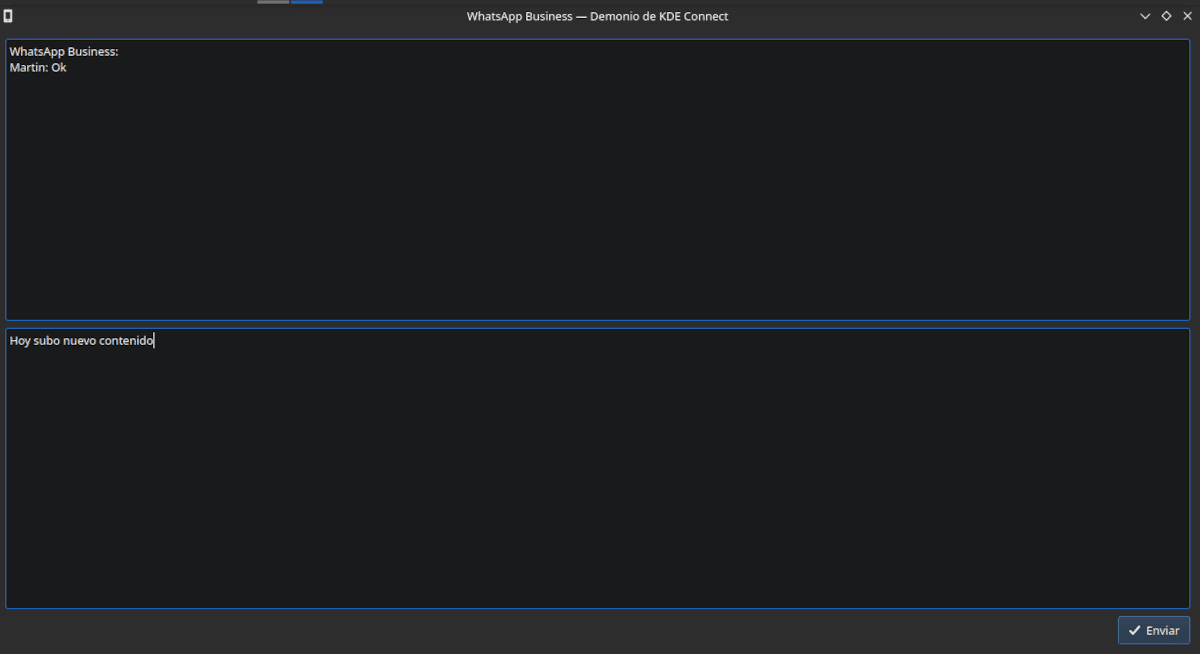
Despite its disadvantages compared to its competitors, WhatsApp is still the most used messaging application.
Like it or not WhatsApp is the most used means of communication today. And, although the services of the competition are better and more respectful of the privacy of the users, we are forced to use what the majority uses unless we are resigned to losing clients or not knowing what is happening around us. Just ask the free software fanatics who only talked to Softphone Ekiga.
That is why in this article let's see how to install WhatsApp on Ubuntu.
What is WhatsApp
To understand how to install WhatsApp on Ubuntu and the limitations and difficulties we face in doing so, we first need to understand what it is.
WhatsApp Messenger is an instant messaging and voice over IP service owned by Meta (the parent company of Facebook and Instagram). It is used to send text messages and voice messages, make voice and video calls, and share images, documents, user locations, and other content.
The main use is through applications for mobile devices, one aimed at normal users and the other at commercial users, in both cases the service is free. Although the service can be accessed from desktop computers, a cell phone number is required to sign up.
Those who selected the business version can use the web version without the need for the mobile phone to be connected, although they will still need it to access it for the first time.
How to install WhatsApp on Ubuntu
This brings us to the key point. There is no way to install WhatsApp on Ubuntu. Since Meta is determined to make the service profitable and cannot charge to use it since they would all go to Telegram, which it does is to restrict access to its API's (application programming interface) which prevents the creation of third-party applications unless you checkout.
What we can do is choose one of the following alternatives:
- Use WhatsApp Web from the browser.
- Use WhatsApp from a web application.
- Connect the mobile to the computer and use a program that allows us to interact with its screen.
- Use WhatsApp from an Android emulator
- Use libraries that allow us to interact with WhatsApp.
Use WhatsApp Web from the browser

To use WhatsApp Web we have to scan the screen code on the mobile. The mobile must remain connected to the network.
For this we just have to open the browser and go to this page.
The page will show us a QR code that you must scan with your phone. We do it this way:
- We open the WhatsApp application.
- Click on the three dots icon.
- We press on Linked devices.
- Click on Link a device.
- We align the box with the QR code on the screen.
When the phone application reads the code, we will see a notice on the browser screen that it is synchronizing. When finished you will see the messages.
The web version takes a long time to start and, as I told you above, we will need to have the mobile connected to see the messages. However, the Business version offers us in the testing phase the option to view offline.
I recommend cleaning your monitor and getting yourself a phone with a good camera. Otherwise the synchronization process is a real torture.
Web applications
Web applications are nothing more than a browser that opens a single page (in this case WhatsApp Web) for what the only advantage is that we click on an icon and we already have WhatsApp, but, we will have to go through the procedure of scanning the QR code and having the phone connected.
Some web applications are:
- Youp for whatsapp: installable from FlatHub, the advantage of this application is that it incorporates visual improvements to the WhatsApp web interface such as dark mode or full screen viewing. In addition, it shows us notifications on the desktop and changes the bar icon to notify us of new messages
- WhatsApp desktop: Another title on FlatHub. It doesn't add anything interesting.
- WhatsApp for Linux: This application offers some customization capabilities like chat themes and backgrounds. Also, you can use it in full screen mode and have it start with the system.
- ZapZap: The great advantage of this program is to keep running in the background. Does not allow calls.
- Francis: One of the few applications that really brings something to this list. It gives us access to various messaging services including: Slack, WhatsApp, WeChat, HipChat, Facebook Messenger, Telegram, Google Hangouts, Group Me and Skype. Allows screen sharing.
- What Desk: For some reason it is the one recommended by everyone who writes on this subject. it's just a navigator turned into an Electron app and the only thing it adds is the notification on the top bar.
Connecting the mobile to the computer

With KDE Connect we can make the mobile send WhatsApp notifications to the computer and respond to them.
If free software beats proprietary software in anything, it is in the applications that allow us to connect the mobile to the computer so that we can interact. In this case there are two titles that stand out. Scrpy and KDE Connect.
scrcpy
scrcpy It allows us to establish a connection with the mobile wirelessly or connected. This program is obtained in the repositories or in the store of Snap.
First we need to enable developer options on mobile. For this we will have to go to the configuration section where the Android build number is and press it seven times. Then we go to System → Advanced Options (It may be in another location) and click on Options for developers. We activate USB debugging.
A window will open on the phone that authorizes you to establish the connection.
Once this is done, you will see the screen of your phone appear on the computer monitor. You just have to click with the mouse on the WhatsApp icon to open the application. Although we can write with the computer keyboard, Spanish characters such as ñ or ¿ do not work, to use them we must press on the on-screen keyboard with the mouse.
KDE Connect
It is in the repositories of KDE-based distributions and there is a gnome-version which is installed as an extension. The mobile application can be installed from the App Store from Android or (my recommendation) from F-Droid.
Once with the computer and the phone connected to the same network, we start both applications and from the mobile we give the necessary permissions. When a message arrives we will see the notification and we will have the possibility to respond to it.
Install an Android emulator to use WhatsApp

Using Anbox we can run Android in a container and install Anbox on it.
This method is completely inadvisable. Not only because it is a waste of resources on our computer, but also because we will no longer have WhatsApp available on our mobile. At least with the number we're using.
Anbox is a free and open source application to run Android applications on Linux.. It is based on the latest version of the Android Open Source Project (AOSP) and offers a window-based Android environment. It uses container technology to run the phone's operating system.
We can install it with:
sudo snap install --devmode --beta anbox
Next, we check that we have the necessary dependencies
sudo modprobe ashmem_linux
sudo modprobe binder_linux
lsmod | grep -e ashmem_linux -e binder_linux
if they are not
sudo apt install mokutil
sudo mokutil --sb-state
We reboot the system.
sudo reboot
Now we install the Google app store:
We get the dependencies
sudo apt install wget curl lzip tar unzip squashfs-tools
We download the installation script
wget https://raw.githubusercontent.com/geeks-r-us/anbox-playstore-installer/master/install-playstore.sh
We make it executable
chmod +x install-playstore.sh
we run it
./install-playstore.sh
Anbox may not connect to the network. We solve this with the following procedure
We reset Anbox
sudo systemctl restart snap.anbox.container-manager.service
Copy and paste the code this page into a text file and save it as bridge.sh
We give permissions.
chmod +x bridge.sh
We run with
sudo ./bridge.sh
We will have to do the same every time you restart session.
Then we restart Anbox and click on Settingyes Now we are going to Google Play Services y Google Play and clicking on Permissions we give it to them
Next, we close the window, click on the Google Play symbol, log in and install WhatsApp with the usual procedure. We will need a mobile phone to receive the authentication code.
Use libraries that allow us to interact with WhatsApp
As I said above, the owners of WhatsApp demand that if you want to create your own solutions to use the WhatsApp network, you have to pay. Although partial reverse-engineered solutions appear on GitHub from time to time, they don't work for too long. What does usually work best is a set of Libraries based on Python that interact with WhatsApp Web executed from the browser. I've tried a couple and had partial success, but nothing to justify the complicated setup. If you're curious take a look at whatsapp-web 0.01 and Auto whatsapp 0.0.5.
Which is the best option?
For me, the most practical is WhatsApp Web, the other options require too much time, resources, or contribute too little.
I recommend Walc. Binary AppImage and is not platform dependent. I've been using it for a long time and it hasn't given me any problems so far.
https://github.com/WAClient/WALC
Thanks for the tip
Rambox, the birthplace of Ferdinand and Franz, is an excellent option. Even up to version 0.8.0 (totally free) it can still be used.
I installed it on Ubuntu Mate 20.04 and on Windows 7 (portable version) and they work without problems!
Good date. Thank you
¿»WhatsApp Desktop: Another title on FlatHub. It doesn't add anything interesting."?
It is a recreation of the native application for Windows, but for Linux in Flatpak, it even brings an icon for the icon tray.
You don't have to contribute anything, it just has to work, Whatsapp Desktop (Flatpak) is probably the simplest and most similar to the original.